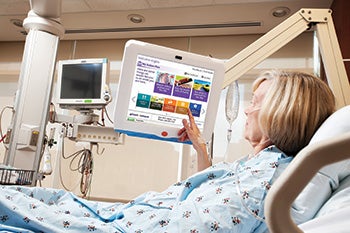Patient television systems
 |
| This system from GetWellNetwork helps patients to understand and participate in their care. |
Patient education and entertainment systems have evolved over the past five years into patient engagement systems, according to leading system providers. Solutions have advanced from basic methods of nurses conversing with patients and leaving printed material, through bringing a TV and VCR cart into the room, to current interactive systems that deliver content on the in-room television, accessed and navigated from the patient’s pillow speaker.
Moreover, the technology now integrates with almost every hospital system so that clinical efficiencies are achieved, and patients are able to access several points of information to better understand their care, says James A. Christensen, senior vice president of sales and marketing for SONIFI Healthcare, Los Angeles. “This technology reaches beyond the traditional in-room patient television and onto hospital-owned and patient-owned tablet devices. This allows several different access points for the patient and caregiver.”
Systems can be integrated with a patient’s electronic health record (EHR) to deliver or record information specifically for that patient. GetWellNetwork, Bethesda, Md., offers a system that interfaces with 64 unique information technology (IT) systems, ranging from EHRs to real-time locating systems, meal ordering and patient portals. “This interoperability leads to a more comprehensive patient experience,” says Michael O’Neil, founder and chief executive officer. “Above all else, the technology has spread outside the walls of the hospital to ambulatory and home settings.”
Multilevel platforms
“In addition to the traditional role of education and entertainment provider, interactive patient engagement platforms are now used to streamline operations, enhance the patient experience and increase revenue. For example, our platform can interface with major food service providers, which allows patients to order their meals through the television,” says Tom Klopack, CEO, Skylight Healthcare Systems, San Diego.
The latest education and entertainment systems provide patients with information on their conditions, treatment and recovery, using video instruction to target certain demographics. “For example, interactive systems can read demographic data from within the EHR,” says George Fleming, CEO of TeleHealth Services, Raleigh, N.C. “That information can trigger the learning experience in a different language, or possibly a different user interface with increased font sizes. In turn, it can deliver information to a certain subset or at-risk population.” Interactive patient engagement systems also can deliver specific educational curricula based on a diagnosis code, or education on a prescription based on a pharmacy order, he adds.
GetWellNetwork is based on interoperability, according to O’Neil. “Our platform is electronic medical record-agnostic and we integrate through industry standards such as HL7 [Health Level Seven International], REST [Representational State Transfer] and SOAP [Simple Object Access Protocol] Web service interfaces. This integration enables us to pull patient-specific data to personalize the patient’s experience based on such factors as age or language preference, as well as to trigger, automate and standardize clinical processes for greater efficiency and compliance,” he says.
The SONIFI system integrates with several hospital systems, creating an environment specific to each patient, according to Christensen. This allows patient and caregiver to access information on the patient’s condition, care team members and schedule. “Video education is provided through the interactive system. This allows care team members to assign education for required patient viewing and document what the patient watched. We work with clinical and educational teams to ensure that the content is relevant to the hospital’s needs.” The impact of this process on nurse workflow can be significant; the company has observed an average of two-hour savings during a 12-hour shift, he adds.
The latest platforms address nonclinical requests as well, allowing patients to change room temperature, order meals, purchase medications from the pharmacy and purchase items from the gift shop. This helps patients to prepare for recovery before they leave the hospital as well as boosting retail revenue.
Post-discharge connections
Many systems are designed to engage patients after they go home, offering post-treatment content remotely. “This is the current hot spot for patient education, and the focus of many health care systems and interactive system providers. Until recently, interactive systems were primarily used to educate the patient while increasing caregiver efficiency in the hospital,” says Timothy Wright, director, commercial health care, LG Electronics USA Inc., Englewood Cliffs, N.J.
“Under the current regulatory environment, access to post-discharge medical education for the patient and family is now recognized as crucial to minimizing readmissions and improving outcomes. This content is most commonly provided to the patient’s home via Internet from the hospital, physician’s office or an interactive solution partner,” he adds.
“Currently, post-discharge engagement is believed to be around 10 percent and growing steadily. Many patients in need of this information are at an age or [have a] condition that may limit their grasp of, or comfort level with, the technology. However, this trend is accelerating rapidly due to the emergence of a more tech-savvy patient population, development of more intuitive systems and economic necessity,” Wright says.
Klopack reports a growing registration rate among hospital clients using the Web-based portion of the Skylight interactive patient engagement platform. Some hospitals are more aggressive than others; some only use it for specific patient populations, while others have more patients or have been using the system longer. “The newest hospital using the platform has a registration rate of 37 percent while another has a rate of 60 percent. More than half the hospitals have a registration rate of around 50 percent,” he says.
The latest systems have helped hospitals to improve patient outcomes and avoid costs due to readmissions, experts agree. One example is St. John’s Children’s Hospital, Springfield, Ill., which implemented GetWellNetwork’s GetWell Town to enhance the care experience for its pediatric patients and their families. The hospital was transitioning to an EHR system, and GetWellNetwork’s solution provided a way to integrate several technologies into the care process.
GetWell Town provides St. John’s patients with kid-friendly, personalized tools and content, including educational videos as well as TV and Internet access. Patients and families also use the system to provide feedback during their stay so that hospital staff can immediately review and address any needs or concerns. Hospital President Peggy Curtin says, “Integrating GetWellNetwork into the care process has made a significant difference not only for our patients and families in terms of satisfaction with pain management, but also for our health care team.”
Another example is University Hospitals Case Medical Center, Cleveland, which improved its discharge process by using the Skylight CareNavigator to give staff and patients easy access to discharge information and planning. A discharge informational video is loaded onto the CareNavigator system; 36 hours after a patient is admitted, the system automatically delivers a message to the patient’s television screen. “The system helped our patients better understand the discharge process,” says Marilyn Kabb, director, acute care, medical-surgical nursing administration.
It is important to segment patients based on risk of adverse events and readmission, according to Christensen. “The SONIFI health care solution identifies patients that have misinterpreted the information provided and alerts hospital staff to this risk for follow-up. The system incorporates an interactive engagement solution that uses patient activation measures licensed through Insignia Health to identify high-risk individuals.”
Entertainment options
On the entertainment side, hospitals lag behind both homes and hotels in providing a high-definition (HD) television experience, according to Fleming. “We estimate that fewer than 30 percent of hospital rooms have HD-quality programming, although almost 75 percent have HD televisions. TeleHealth Services is striving to educate hospitals about the low cost of bringing HD programming to the patient, often without major recabling of the coaxial network,” he notes.
Many patients find an unsatisfactory viewing experience in hospitals, especially compared with the robust video offerings they’re used to at home, adds James Moore, director, video product management, Time Warner Cable Business Class, New York City. At the same time, health care facilities are eager to replicate that in-home experience to help create a comfortable setting for patients.
“Time Warner Cable Business Class HD Video for Healthcare provides medical facilities with a cost-effective way to upgrade to an HD programming solution that is patient-friendly. The service, which interfaces with most bedside pillow speakers, provides HD video, hours of free on-demand programming and an interactive program guide,” Moore says.
On the hardware side, a high-definition, hospital-grade television should be used to enhance the patient experience, experts agree. Most patients are used to this level of resolution at home and it’s much easier to see important details such as text and graphics on the screen. A high-definition display from 32- to 42-inch diagonal is optimal for delivering this information in patient rooms.
Future advances
Looking ahead, the most obvious technological advances will encompass the wireless manner in which content is delivered, experts agree. Cloud-based content will provide patients and staff with educational information, as opposed to locally stored content. Internet Protocol-based and “bring your own” content will begin to replace the entertainment programming currently delivered via satellite or cable.
“The latest LG Pro:Centric TVs offer a mobile high-definition link, which allows users to connect smartphones to the TV,” says Wright. “Unlike the ‘Smart TV’ consumer experience, however, a hospital environment brings unique challenges to manufacturers and integrators due to privacy issues and content security. We develop applications only with licensed content partners and app developers to ensure compliance. There is still more work to be done in this area.”
Despite the capabilities of new education and entertainment systems, hospitals have a long way to go to get and keep patients networking with providers, cautions Fleming. “One of the Stage 2 meaningful use criteria sets a 5 percent patient health care portal usage standard. When you think about the numbers, this is a pretty low expectation; however, when you combine both health and technology literacy, we as a country have a true challenge ahead of us.” HFM
is a freelance health care writer based in Mundelein, Ill.
For more information
For further details on the patient television systems featured in this report, contact the following vendors:
» GetWellNetwork
» LG Electronics USA Inc.
» Skylight Healthcare Systems
» SONIFI Healthcare
» TeleHealth Services
» Time Warner Cable Business Class




